Related Research Articles
This is a list of aviation-related events from 1922:
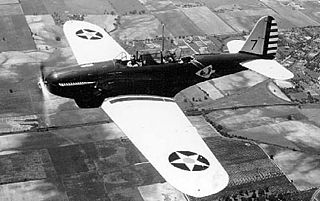
The Consolidated P-30 (PB-2) was a 1930s United States two-seat fighter aircraft. An attack version called the A-11 was also built, along with two Y1P-25 prototypes and YP-27, Y1P-28, and XP-33 proposals. The P-30 is significant for being the first fighter in United States Army Air Corps service to have retractable landing gear, an enclosed and heated cockpit for the pilot, and an exhaust-driven turbo-supercharger for altitude operation.

The General Aviation XFA was an American biplane fighter aircraft built by the General Aviation Company for the United States Navy.

The Boeing XF6B-1 / XBFB-1 was Boeing's last biplane design for the United States Navy. Only the one prototype, Model 236, was ever built; although first flying in early 1933, it rammed into a crash barrier in 1936 and the design was not pursued further.
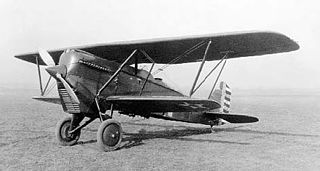
The Boeing XP-7 was a prototype United States biplane fighter of the 1920s.

The Boeing XP-15 was a prototype monoplane fighter of the United States, the second to be designated a pursuit type, after the Boeing XP-9.
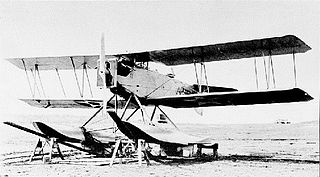
The Aeromarine AS was a seaplane fighter aircraft evaluated by the US Navy in the early 1920s.

The Berliner-Joyce XF3J was an American biplane fighter, built by Berliner-Joyce Aircraft. It was submitted to the United States Navy for their request for a single-seat carrier-based fighter powered by a 625 hp (466 kW) Wright R-1510-26 engine.
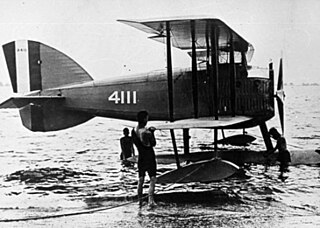
The Curtiss HA was an American biplane seaplane designed by Captain B.L. Smith of the United States Marine Corps, and built by Curtiss Aeroplane and Motor Company.

The Curtis XF13C was a carrier-based fighter aircraft built by Curtiss Aeroplane and Motor Company.

The Douglas XFD was a carrier-based biplane fighter aircraft designed for the United States Navy, and the first fighter to be built by the Douglas Aircraft Company. A victim of changing requirements, no production was undertaken.

The Loening PA-1 was an American fighter aircraft prototype built by Loening Aeronautical Engineering.
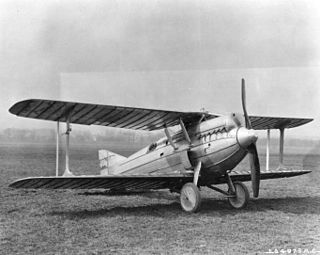
The Gallaudet PW-4 was a prototype biplane fighter aircraft built by the Gallaudet Aircraft Company. It was one of the last projects by the company before it was taken over by Consolidated Aircraft. It was all-metal and powered by a Packard 11A-1237 engine. Three prototypes were ordered by the USAAC, but the company could afford to build only one, which never flew.
The Martin KF-1 was an American biplane fighter aircraft designed and built by Captain James V. Martin.
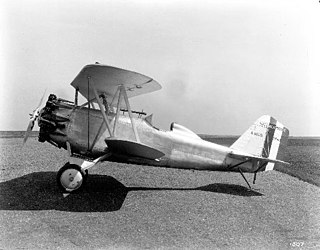
The Hall XFH was an American fighter aircraft built by the Hall Aluminum Company. It was the first fighter with a semi-monocoque metal fuselage.

The Orenco D was an American biplane fighter aircraft, designed by Orenco and built by Curtiss Aeroplane and Motor Company. It was the first fighter type of completely indigenous design to enter US military service.
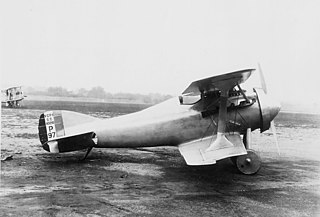
The Verville VCP was an American single-engined biplane fighter aircraft of the 1920s. A single example of the VCP-1 was built by the United States Army Air Service's Engineering Division, which was later rebuilt into a successful racing aircraft, while a second, modified fighter was built as the PW-1.

The Thomas-Morse R-5 also known as the TM-22 was an American single-engined parasol monoplane racing aircraft of the 1920s. Two were built for the United States Army Air Service in 1922, but after competing in the 1922 Pulitzer Trophy Race the type was abandoned.

The Vought V-141 was a prototype American single-seat fighter aircraft of the 1930s. It was a development of the unsuccessful Northrop 3-A design, but was itself a failure, being rejected by the United States Army Air Corps. The sole prototype was sold to the Japanese Army in 1937, but no production followed, with the type proving to be inferior to existing Japanese fighters.
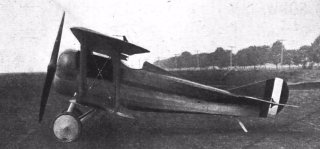
The Orenco B was a prototype American fighter aircraft of World War I. It was a single-engined, single-seat biplane that flew in 1918. Although it demonstrated good performance, it did not enter large scale service.
References
Bibliography
- Angelucci, Enzo (1987). The American Fighter from 1917 to the present. New York: Orion Books.
| This aircraft of the 1930s article is a stub. You can help Wikipedia by expanding it. |